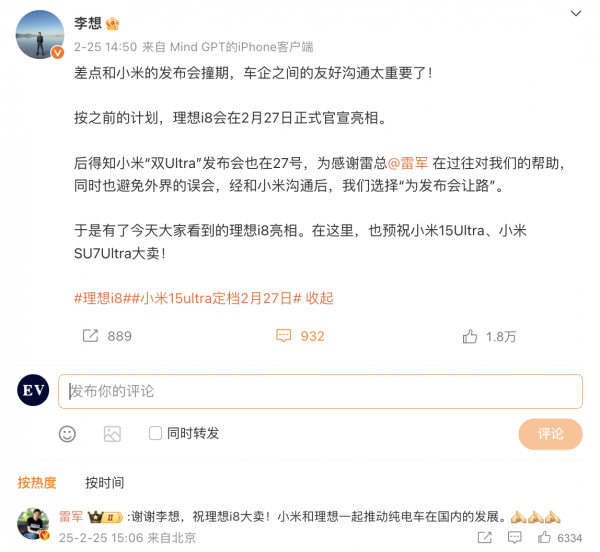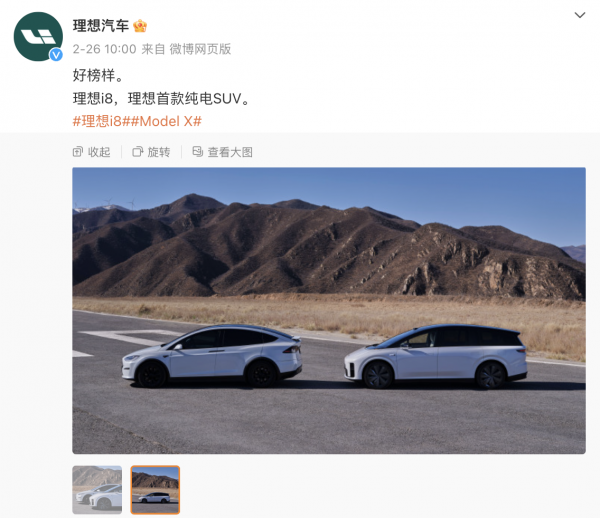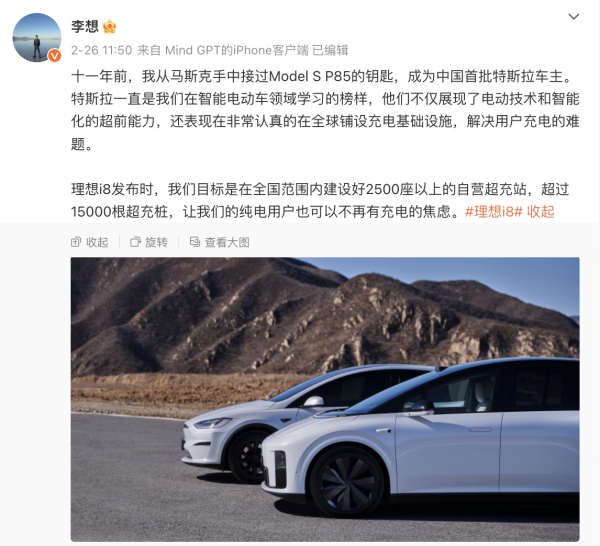"Weibo expert" Li Xiang reactivated, Li Auto i8 cannot afford to fail
![]() 03/05 2025
03/05 2025
![]() 632
632
Li Xiang, CEO of Li Auto, has significantly increased his activity on social media over the past week, as the company's first pure electric SUV, the Li Auto i8, has officially debuted and is confirmed to be launched in July this year.
Having only posted 9 Weibo updates in the past six months is unusual for the once "Weibo expert" Li Xiang, and 6 of these updates are highly related to the Li Auto i8.
On February 25th at noon, Li Xiang made his second Weibo post of the year, explaining the meanings of Li Auto's two major product series, L and i. Earlier that morning, the company publicly released the first exterior images of the i8.
The i8's unexpected debut without preheating sparked a frenzy in the secondary market. Li Auto's Hong Kong stocks surged in the morning session, hitting a maximum intraday gain of over 16%, the largest since late February 2024.
Later that afternoon, Li Xiang posted that the Li Auto i8 was originally planned to be officially announced on the 27th of that month, but to avoid a clash with Xiaomi's "Dual Ultra" launch event, Li Auto chose to "make way for the launch event." Subsequently, the topic of "Lei Jun thanking Li Xiang" trended on Weibo.

Behind Li Xiang's renewed high-frequency updates on Weibo is, on the one hand, the momentum building for the upcoming new car launch; on the other hand, this pure electric SUV, which has been delayed for a year, cannot afford to fail.
According to Li Auto's original pure electric strategy release schedule, the company will launch four pure electric models in 2024, including the first pure electric MPV, the Li Auto MEGA, to be launched in March, and three pure electric SUV models to be launched in the second half of the year.
However, the Li Auto MEGA encountered setbacks in its first month of launch, disrupting the company's plans for new series and models. Subsequently, Li Xiang stopped updating his Weibo, and the company's sales expectations were quickly adjusted, including lowering first-quarter delivery guidance and full-year sales targets.
Judging from Li Xiang's latest statements, the company's first pure electric SUV is now ready after a year-long delay, awaiting only the completion of road tests and further improvements to the charging network.
On March 3rd, Li Xiang posted on Weibo, "In terms of product competitiveness for a six-seat pure electric SUV, we are very confident in the Li Auto i8. Users with clear needs for second-child and three-generation family cars can wait patiently for the Li Auto i8. The product's performance and the Li Auto supercharging stations spread across the country will definitely satisfy you."
As for the launch schedule of subsequent models in the Li Auto i series, it will depend on whether the i8 can replicate the blockbuster success of the Li Auto L9 after its release.
1. Why is the first model the i8?
As Li Auto's new pure electric SUV series, the i series is an independent product line from the L series and MEGA, forming Li Auto's product family together.
The Li Auto L series currently includes the L6, L7, L8, and L9, positioned as five-seat mid-size SUVs, five-seat mid-to-large SUVs, six-seat mid-to-large SUVs, and six-seat full-size SUVs, respectively, with launch dates of April 2024, February 2023, September 2022, and June 2022.
Judging from Li Auto's placement of the i8 alongside the L9 and MEGA in the exterior images, the actual positioning of the i8 within the company's pure electric SUV series is likely to correspond to that of the Li Auto L9 within the extended-range SUV series, i.e., the most premium model.
Referring to the launch timeline of the four Li Auto L series models, it is not difficult to judge that the i series will also inherit this top-down release rhythm. At the same time, this aligns with the common "top-down" strategy adopted by automakers when launching a series of new cars.
As for why the first model is not the larger i9 (if it exists): on the one hand, the market capacity for large pure electric SUVs is relatively small; on the other hand, in an era where sales are king, choosing the i8 as the first model is Li Auto's safest approach to balancing price and sales volume.
According to data from Yiche.com, in 2024, the AITO M9 pure electric version topped the domestic large pure electric SUV sales chart with 16,000 units sold. The second-placed Mercedes-Benz EQS pure electric SUV sold only 405 units for the entire year.
In comparison, the market for mid-to-large pure electric SUVs is much larger. In 2024, IM Motors LS6, IM Motors R7, and Buick E5 ranked first, second, and third in sales in this segment with 34,000, 29,000, and 22,000 units sold, respectively. Competitors in the same class also include Xpeng G9, AVATR 11, NIO ES8, etc.
If the first model to be launched is the cheaper mid-size pure electric SUV Li Auto i6, it will immediately fall into a competitive red ocean upon launch. In addition to strong competitor Tesla's new Model Y, the i6 will also face competition from existing models in the market such as NIO ES6, Xpeng G6, BYD Song L, etc.
However, if the i8 is placed in the more segmented six-seat mid-to-large pure electric SUV market, the car's chances of success are obviously greater.
After Li Auto released the side view of the i8 on February 26th, it also tagged Tesla Model X. Besides leveraging the comparison, the company likely also sees Tesla Model X as a competitor to the i8 internally.

Currently, Tesla Model X is available in China in two versions: the Dual Motor All-Wheel Drive version and the Plaid version, priced starting at RMB 724,900 and RMB 824,900, respectively; the former offers consumers a choice of 5/6/7 seating layouts, while the latter is only available in a six-seat version.
For a pure electric SUV that aims to both sell in volume and position itself as premium, the pricing of the Li Auto i8 will obviously be more "affordable" than that of the Tesla Model X.
2. Why is the launch in July?
According to Li Auto's official statement, the company hopes to bring the i8 to market sooner to meet users' expectations for the first pure electric SUV, but it also wants to allow more time for the test vehicles to remove heavy camouflage and undergo more rigorous road testing and validation to ensure that the mass-produced vehicles are more stable and reliable.
However, in reality, Li Auto is still accelerating the improvement of its charging network.
Last May, Li Xiang mentioned in the company's first-quarter earnings call that the insufficient number of self-operated supercharging piles and the need to increase the number of exhibition stands and retail stores were the main reasons for the delay in the launch of Li Auto's pure electric SUV.
He believes that the appropriate time to launch the product into the market is when Li Auto's self-operated supercharging piles reach the same number as Tesla's.
On February 26th, when Li Xiang posted his fourth Weibo of the year, he stated that the company's goal by the time of the Li Auto i8 launch is to build more than 2,500 self-operated supercharging stations nationwide, with over 15,000 supercharging piles, so that pure electric car users can also have no charging anxiety.

He also took the opportunity to praise Tesla on Weibo: "They not only demonstrated their advanced capabilities in electric technology and intelligence but also showed their seriousness in deploying charging infrastructure globally to solve users' charging problems."
According to data released by Tesla, as of August 2024, the company had launched over 2,000 supercharging stations and over 11,500 supercharging piles in China.
Since Li Auto built its first supercharging station in April 2023, the company has been accelerating its construction of the charging network. As of the end of February this year, Li Auto had launched 1,873 supercharging stations with a cumulative total of 10,000 charging piles.
In terms of the sales network, Li Auto is also accelerating its expansion. According to data released by the company on March 1st, Li Auto opened a total of 13 new stores in the first two months of this year, including 6 comprehensive centers, 2 retail centers, 2 delivery centers, and 3 service centers.
As of the end of February this year, Li Auto's three-tier network has covered 224 cities nationwide, with 500 retail centers, 136 delivery centers, and 488 service centers. Among them, the number of covered cities has increased by 10, and the number of retail centers has increased by 13 compared to the end of May last year.
In addition, Li Auto's choice to launch the i8 in July is likely also to leave room for maneuvering in pricing. After all, Xiaomi's first SUV, the Xiaomi YU7, will be launched in June or July this year. Prior to this, Xiaomi's first car, the SU7, and its high-end version, the SU7 Ultra, have already received full recognition from the market and users.
Although the Xiaomi YU7 and the Li Auto i8 are not entirely in the same market segment, as pure electric SUVs, the final pricing of the Li Auto i8 will inevitably refer to the Xiaomi YU7, which will be launched first, as well as other competitors launched during the same period, including the new AITO M8.
3. Will there only be the i8 this year?
In March last year, when reviewing the reasons for the MEGA's setback in an internal letter, Li Xiang mentioned that Li Auto mistakenly treated the MEGA's commercial validation period as a period of rapid growth. He believes that the Li Auto MEGA and high-voltage pure electric vehicles must go through a similar stage from 0 to 1 as the Li Auto ONE and extended-range electric vehicles did.
Therefore, for the company's new pure electric SUV series, only after the Li Auto i8 achieves results similar to the Li Auto ONE and Li Auto L9 will subsequent models such as the i6, i7, and i9 be released smoothly. This is also the "nested doll" model established by Li Auto around blockbuster single models after the successful launch of the L series.
As the company's first model, the Li Auto ONE was delivered starting in December 2019 and continued to be sold for two years and ten months before being completely discontinued and replaced by the successor model, the Li Auto L8.
During this period, the Li Auto ONE sold a cumulative total of 212,000 units, making it the first Li Auto model to reach 200,000 deliveries. Subsequently, the Li Auto L6, L7, L8, and L9 reached this delivery scale in 9 months, 17 months, 26 months, and 25 months, respectively. Judging from the data since delivery, the L8 also has the strength to succeed the Li Auto ONE.

Moving on to the Li Auto L9, a six-seat full-size SUV that focuses on extended range, the vehicle was launched in June 2022 with a price of RMB 459,800. Within 72 hours of opening pre-orders, the Li Auto L9 received over 30,000 orders, demonstrating its appeal to consumers. By August 1st, 2022, confirmed orders for the Li Auto L9 exceeded 30,000, with cumulative pre-orders exceeding 50,000.
In addition, having learned from the MEGA's setback, Li Auto is bound to prudently validate the user acceptance of the i8, including a four-month preheating period before the launch and the number of pre-orders after the launch. Therefore, the company is not in a hurry to launch models such as the i6 and i7.
On the other hand, although L and i are two series and two routes, if the cheaper i6 is launched soon, it may compete with the current sales pillar of Li Auto, the L6, which is something neither Li Xiang nor the company wants to see.
In mid-January this year, the Li Auto L6's cumulative deliveries exceeded 200,000 units in less than nine months after its launch, setting a new record for the fastest time for a Li Auto model to reach this scale. The discontinued Li Auto ONE took 22 months. In 2024, the Li Auto L6 delivered a cumulative total of 192,000 units, accounting for over 38% of deliveries and becoming Li Auto's highest-selling model for the year.
With just one model, Li Auto has already surpassed Xpeng Motors' total deliveries for last year. As of the end of January this year, the Li Auto L6 has been ranked first in domestic extended-range car sales for eight consecutive months.
According to Li Auto's "nested doll" model, if the i8 quickly passes through the commercial validation period, the release schedule for subsequent models will accelerate. However, if the "MEGA-style setback" is repeated, the company's pure electric SUV models this year may be limited to the i8 only.







